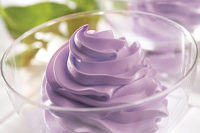Say cheese!
That’s good to know because perhaps the only other colors that get as much play in dairy as red are the orange and yellow shades of cheese and butter. Color suppliers have done yeoman’s work in delivering such colors, and have done so using mainly exempt options like beta carotene — a staple in butter — and the annatto we so often see in cheese.
But just because these colors appear frequently in dairy doesn’t mean we can take a one-size-fits-all approach to using them. Consider a processed cheese. “The alkaline, water-soluble annatto cheese color used to color natural cheese such as Cheddar and Colby cannot be used in processed cheese,” Locey said. The high levels of certain proteins in natural cheese can combine with norbixin, causing it to precipitate and generate “pinking” in the finished cheese. Locey recommends alternative formulations and notes that processed cheese is an ideal application for oil-soluble forms of annatto and paprika.
When the task is coloring a cheese powder destined for later use — in a boxed pasta dinner, for example, or as a seasoning on a snack — different considerations take center stage. Locey suggests using encapsulated colors in dry mixes requiring long shelf life, while pointing to a blend of oleoresin paprika and annatto or carrot extract to achieve the bright yellow-orange hues we associate with cheese-flavored snacks. “These products will provide a clean label and appeal to the consumer,” she said.
Renner-Nantz notes that annatto’s reliable heat stability should guard it against any damage during subsequent processing — extrusion, frying, baking or otherwise. “You could actually put the annatto into a snack matrix itself if you’d like to give it that yellow-orange appearance of Cheddar,” she said. And for more impact, she suggests a post-process application of a dry topical cheese powder for “even more of that stick-to-your-fingers quality.”
Katz has advice for those working with carotenoid colorants. The beta carotene crystal, he explained, “is sparingly soluble in oil, so it must be milled into a suspension to make it suitable for oily applications.”
In fact, the primary delivery forms of carotenoids, like beta carotene, apocarotenal and canthaxanthin, are oily suspensions of finely milled crystals or spray-dried powders. For aqueous applications, his company supplies liquid emulsions and encapsulated carotenoids, “prepared by creating an emulsion and then spray-drying or spray-drying in cornstarch” to confer extra protection to the carotenoid colorant.






